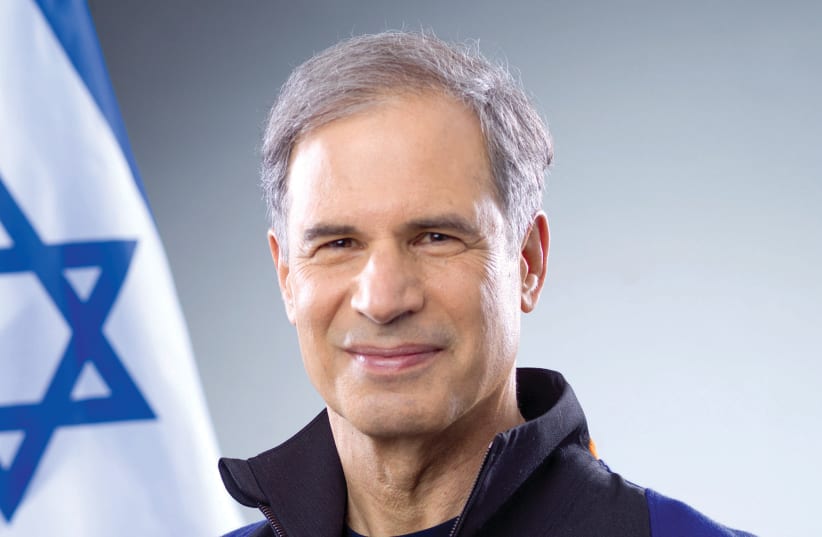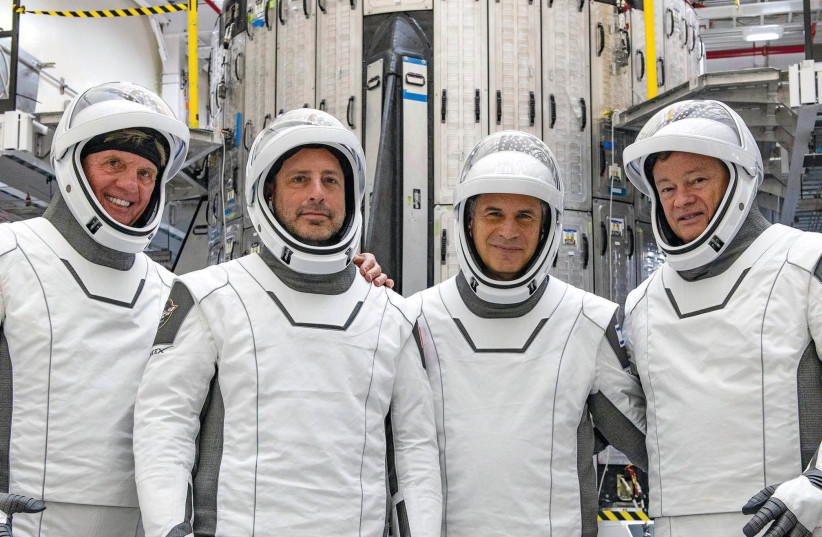Axiom Space has sent its first privately manned mission to space with Israel’s second astronaut, Eytan Stibbe, and his Ax-1 team lifting off for the International Space Station on April 8. Stibbe spoke to The Jerusalem Report via Zoom from Florida, where he was in quarantine prior to the launch.
A former Israeli Air Force fighter pilot, businessman and philanthropist, Stibbe has become somewhat of a media star himself. Many in Israel and around the world are cheering on the mission of the second Israeli astronaut in space. The launch was delayed multiple times due to NASA’s Artemis mission, which sent an unmanned craft to the moon as well, and inclement weather conditions.
Onboard the SpaceX Crew Dragon spacecraft with Stibbe are former Spanish-American NASA astronaut and Axiom Space vice president Michael López-Alegría, and paying passengers Larry Connor, 72, an American real estate and technology entrepreneur and Mark Pathy, 52, a Canadian businessman and philanthropist.
The team plans to spend 10 days aboard the space station. Once the Ax-1 crew returns, another team, Crew-4 is next in line. Their focus for now has been on the 35 experiments engineered by Israeli start-ups and research universities that will get a chance to have their technology tested in space.
“We’ve been focused on what we plan on doing aboard the space station,” says Stibbe. “We’ll have to make many adjustments in zero gravity conditions. We sat down with experienced astronauts who taught us how to carry out experiments in space – where objects float around. Each task is quite a complex procedure.”
The work, he noted, is purely scientific, but he also plans on giving lectures in Hebrew to Israeli schoolchildren in physics, namely on how fluids perform in gravity. “Everything works differently in space,” he said.
Another focus for Stibbe will be conservation methods. “Earth is our very own spaceship and needs to be protected,” he said. “I believe that sustainability is crucial. The space station is an amazing model in that aspect: we recycle water, everything is powered by solar energy, we grow plants sustainably and produce calorie-efficient food.”
Stibbe said he wasn’t worried that Russia’s war against Ukraine would affect the International Space Station, which sees Russian cosmonauts and US astronauts working well together. “The station is a large international laboratory where people work for the sake of the earth, for the sake of peace, and for the good of humanity,” he said. “There are no political discussions onboard. We want to maintain this platform, and stay focused on our experiments.”
Asked whether he believes that astronauts are above earth-based human conflicts, he pivoted. “Consider an American researcher at a Russian institute. He wouldn’t be affected by international tensions but would continue with his research. I don’t think it will affect our work on the ISS – it’ll be business as usual. Astronauts sit and eat breakfast and dinner together every day. The environment is peaceful.”
The training, he said, included a guide to where tools are located on the station, which will house 11 astronauts, including Stibbe and his crew. “Space onboard is very limited, and we needed to learn where everything is located,” he said.
Functioning in microgravity is also difficult to grow accustomed to, and the group underwent intensive training at the Johnson Space Center’s facilities in Houston. They also practiced the complex maneuvers needed to enter the SpaceX Dragon capsule and return back home. The team learned how to do routine things in space, such as using the kitchen, preparing food and water, and using the restroom. “We also learned how to shower in space,” he added with a smile. “Things just float away. You can’t really shower in space, but you can rinse off using a damp cloth, soap, and dry shampoo.”
The team’s workload is packed. Each astronaut has a highly-detailed schedule to ensure that they have sufficient time to work on their experiments, plug in their devices to the limited number of electric sockets, and photograph each step of the process for learning purposes. “Everything is calculated right down to the minutes,” Stibbe said.
Additionally, every astronaut is equipped with a personal computer, an iPad, and email connectivity, which are all better communication tools than those available to the first Israeli astronaut, Ilan Ramon. Ramon was killed together with six crew members in the 2003 Columbia disaster when the spacecraft disintegrated during reentry.
Stibbe’s mission is called “Rakia” (“heaven” in Hebrew), the title of the book published with the fragments of Ramon’s diary that survived the Columbia crash. Stibbe served under Ramon in the Israeli Air Force’s Squadron 117. In 2010, he was part of a group of the Ramon family and friends establishing the Ramon Foundation in memory of Ilan and Asaf Ramon, Ilan’s son who was killed at 21 when his F-16 fighter jet crashed during a training exercise in the Hebron Hills.
Stibbe says Ramon was not only his commander in the air force but also a close friend. “I think of him often, especially because I visited Ilan in Houston back when he was at NASA’s training facilities before he even went to space,” he said. “And even though 20 years have passed, the facilities are still the same. Even some of the things we have onboard have been used many years ago. What works in space stays in space, because it’s terribly expensive to send over new equipment, so plenty of tools remain in the station that were used in the past. I feel that he is still with me.”
For the last 12 years, Stibbe has been actively engaged in the work of the Ramon Foundation, accompanying its educational activities and helping to set its guidelines. Stibbe and his wife, Ora, parents of three kids, are also the founders of the social benefit company Anatta, which supports social and educational initiatives in Israel. They also established the Human Spirit Treatment Center in Lod, which provides subsidized mental health treatment to low-income clients.
During their time in space, Stibbe and the other astronauts can conduct private Zoom calls with their families or even speak to a doctor over a private server.
As for the Israeli start-ups whose experiments and technology he is taking with him to space, Stibbe mentioned that he has been in contact with many companies. “I have tested a lot of the experiments that I will do in space,” he says. “Some are simple, like wearing a helmet for a period of time, or running software. For the more complicated ones, some Israeli scientists arrived in Houston two weeks ago and helped us run trials. We also went through all the medical tests that we’ll conduct in space to get them right.”
Asked how he felt about being part of a major mission, Stibbe remained humble.
“Defining it as a major mission is a little beyond me. I’m excited because this mission is about life, and it excites a lot of people and start-ups who have joined my journey. A year ago, we thought people might be interested, but today that interest has leaped tenfold. The number of requests and questions I receive – to take a nano-sized Bible with me to space and even the questions I get from small children – really amazes me.”
Stibbe, who will be in space for the first night of Passover, took several items highlighting his Jewish heritage into space, including a Hanukkah dreidel, which he says symbolizes the connection between ancient Jewish tradition and the technological innovation of the space mission. And the microgravity and lack of friction in space allows the dreidel to spin endlessly!
“As part of the Rakia Mission to the International Space Station, I will be taking with me a bag filled with items that have a special meaning to me,” he said. “It was clear to me that one of these items would be a symbol of Jewish history.” Among the other items Stibbe took with him are a glass cube inscribed with a prayer for the welfare of Israel presented to him by President Isaac Herzog; a model of the World Peace Bell; an ancient coin dating to the time of the Bar-Kochba Revolt; and a children’s book, Beauty of the World, written and illustrated by Paul Korr, which he was due to read for children while in space.
What is your message to the people of Israel?
“No dream is out of reach.”
The entire country wishes you a safe flight.
“There is a phrase people use in English: ‘Godspeed.’”
I think it’s British.
“When I land, will you find out the origins of that for me?”
Godspeed, Eytan Stibbe! ■

